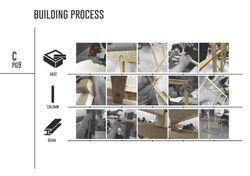Building Construction II
PROJECT 1-
SKELETAL CONSTRUCTION (Temporary Bus Shelter)
In a group of five to six people, our task is to construct a temporary bus shelter according to the following specifications:
- SCALE-The bus shelter should be constructed to accommodate 5-6 people (1:5). Max height is 600mm. Max base size is 400mm x 800mm
- CONSTRUCTION- It should demonstrate the knowledge of skeletal frames and its joints. It must clearly define all building components such as roof, column, walls and floor. The structure should be elevated at least 50mm from the ground.
- FORM - Choose ANY 2 combinations of the following forms for the bus shelter.
- jOINTS -The joints should be constructed to reflect actual joints. For example, if a group chooses recycle steel materials for the frame, the joints should be made to resemble bolts and nuts etc.
- MATERIALS- You are encouraged to use recycled materials such as newspaper, pet bottles, cans, etc. However, the chosen materials must relate to its function. For example, roofing materials should not be made from newspaper.
- OTHER DESIGN CONSIDERATIONS- This is just a minor component however; the shelter should be light and portable. o Resistant to weather. o Allows easy access in and out from the shelter o Shelter SHOULD NOT BE OVERLY DESIGN and must conform to the design criteria.
- TEST-The completed shelter will be tested to withstand lateral forces. In actual situation, from wind and earthquakes or any horizontal forces.
Analysis on the design, construction progress and test results are to be provided in the form of an A3 bound report. We are encouraged to use annotated sketches / diagrams to explain the construction, joints, forces, structural movement experienced during the testing of the shelter. Photographs of the shelter should also be incorporated into the presentation report.









 |  |
|---|---|
 |  |
 |  |
 |  |
 |  |
 |  |
 |  |
 |  |
 |  |
 |  |
PROJECT 2
UNDERSTANDING FORCES IN BUILDING CONSTRUCTION
In this project, we are to propose a building with a grid shell construction and identify the structural systems used in the construction of the building. We are to describe each structural system identified in terms of function, material and load distribution. From there, produce a model on an A3 base showing the structural systems used in the chosen building. A detailed model showing appropriate constructional joints was done in a suitable scale. To further understand the construction and joints, manual axonometric drawings were produced.










